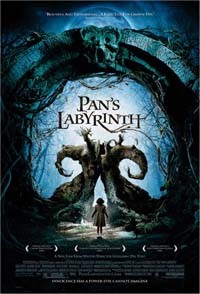Fantasy escapes
When flights of fancy aren’t suitable for children

Guillermo del Toro’s Pan’s Labyrinth (2006)
[
{
"name": "Air - MedRect Combo - Inline Content 1",
"component": "11490391",
"insertPoint": "3",
"requiredCountToDisplay": "1",
"parentWrapperClass": "fdn-ads-inline-content-block"
},{
"name": "Air - MedRect Combo - Inline Content 2",
"component": "11490392",
"insertPoint": "7",
"requiredCountToDisplay": "5",
"parentWrapperClass": "fdn-ads-inline-content-block"
},{
"name": "Air - MedRect Combo - Inline Content 3",
"component": "11490393",
"insertPoint": "12",
"requiredCountToDisplay": "9",
"parentWrapperClass": "fdn-ads-inline-content-block"
}
]
Untitled Document
Children often invent fantasy worlds to escape from
their own harsh realities, and filmmakers have used this as a basis for
their own flights of fantasy. Guillermo del Toro’s Pan’s Labyrinth (2006) has
been lauded as a modern classic, which is more hype than reality. The
fantasy scenes are the weakest element, and they detract from a powerful
dramatic film. Ofelia lives under the tyrannical rule of her new
stepfather, a captain in Spain’s fascist army after the civil war.
The Captain, one of cinema’s most despicable villains, will resort to
any torturous means necessary to gain information about the rebel forces.
Ofelia imagines a large insect to be a fairy that leads her to an imaginary
world of somewhat silly creatures. Do we really need a giant vomiting frog
or a Jar Jar Binks clone to understand her torment? The fantasy scenes
actually take up a smaller portion of the film, and they could have been
easily excised. I doubt that anyone would have sensed that anything was
missing.
An earlier del Toro film suffers from the same
problem. The Devil’s Backbone (2001) haunts another Spanish Civil War-era child with
a mediocre ghost story. Again, the greatest terror comes from a truly
heinous human villain. The director possesses the potential for greatness,
but he doesn’t have the confidence to rely on the reality of his
material.
Terry Gilliam, the real master of fantasy, unleashed
his own psychotic version of Alice in
Wonderland, and it barely saw the light of a
projector. Tideland
(2005) is strange even by Gilliam’s standards. The young daughter of
heroin addicts conjures up her own freakish world after she is left to fend
for herself. Gilliam is better at fusing the fantasy and real worlds, but
that doesn’t make the film any more successful. Tideland simply meanders along without
building any dramatic purpose. Philip Ridley takes a different tack in his
brilliant and unjustly neglected film The
Reflecting Skin (1990). The rural world of
Seth is already strange, and all we need are his interpretations. He
believes that his neighbor is a vampire, and in many ways she appears to be
one. Ridley is able to convey Seth’s fantasy world without ever
veering from the real world. Sometimes less is more.
One final note: None of these films is for children.
New on DVD this Tuesday (July 17): The Number 23, Premonition,
and The Hills Have Eyes II.
New on DVD this Tuesday (July 17): The Number 23, Premonition,
and The Hills Have Eyes II.
Illinois Times has provided readers with independent journalism for almost 50 years, from news and politics to arts and culture.
Your support will help cover the costs of editorial content published each week. Without local news organizations, we would be less informed about the issues that affect our community..
Got something to say?
Send a letter to the editor and we'll publish your feedback in print!

















